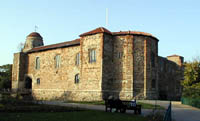| |
 |
Colchester Colchester Castle |
Construction of Colchester Castle started in the reign of William Conqueror, perhaps as early as 1070-1, under the direction of the king's steward, Eudo Dapifer. The castle was later held by him until his death in 1120 when it reverted to the king.
Colchester castle originally consisted of a large defended enclosure in the north-east quadrant of the Norman town and it had a great keep, or fortified palace, in the centre. The keep measures 46.2m x 33.5m (151 feet 6 inches x 110 feet) making it even larger in area than the White Tower in London which was a very similar structure. Battlements preserved in the wall show that work on the keep at Colchester ceased temporarily, perhaps in 1075, when there was a rebellion in East Anglia supported by a Danish fleet. This may have required preparation of the keep for a siege after only the ground floor had been completed. In any event, the building was completed by 1101, although exactly when is uncertain.
The keep rests on the foundations and podium of a great Roman temple. Practically all of the masonry in the keep itself is re-used Roman material, apart from the newly-carved stone for the quoins, window reveals and facing, much of which has now been removed.
At the base of the keep a substantial plinth splays out like a skirt. Above this the building has a ground floor and first floor, although an additional floor was originally planned. Internally the space was divided, first of all, by two major north-south walls, one of which was arcaded and is now missing. In addition, in the south-east corner, on the second floor, there was to have been a chapel with a projecting apse which is reproduced in the plan of the crypt and sub-crypt on the floors below, although the chapel itself may not have been built.
The main entrance to the keep on the south side is, unusually, at ground level rather than on the first floor, although it was protected by an additional defensive structure. West of the entrance is a tower containing a spiral staircase. There are substantial clasping buttresses in the north-east and north-west corners and in the latter there is a second spiral staircase which rises from first floor level. At this level the Great Hall occupied the western side of the building. A second entrance, reached by an outside stair existed at the north end of the Hall. Large fireplaces, two in the west wall and two in the east, are amongst the earliest in medieval England. The keep was reduced to its present height in the late 17th century.
Other buildings, including a hall and a chapel, are known in the castle bailey.
Bibliography
Crummy, P., 1997. City of Victory, (Colchester), 144-9
Drury, P. J., 1982. 'Aspects of the origins and development of Colchester Castle', Archaeological Journal 139, 302 - 419
Pevsner, N., 1965. The Buildings of England, Essex (London, Penguin, 2nd ed. revised by E. Radcliffe), 138 - 9